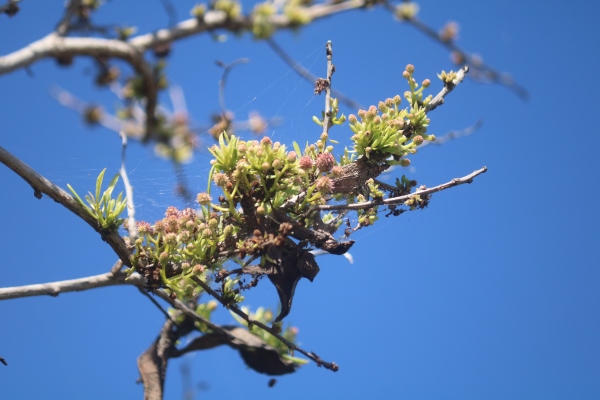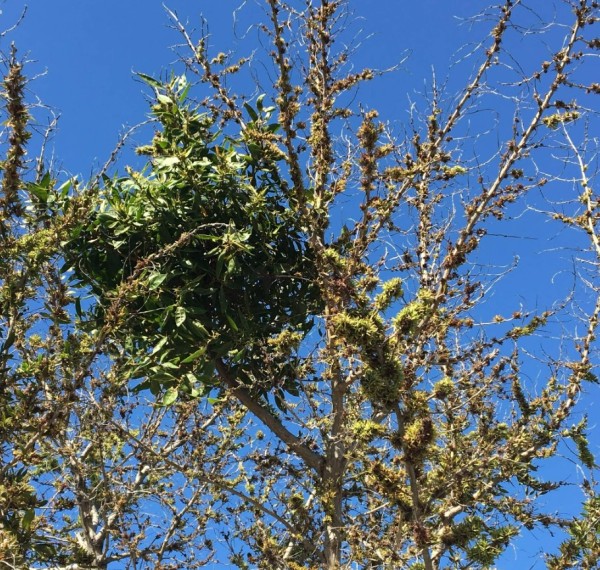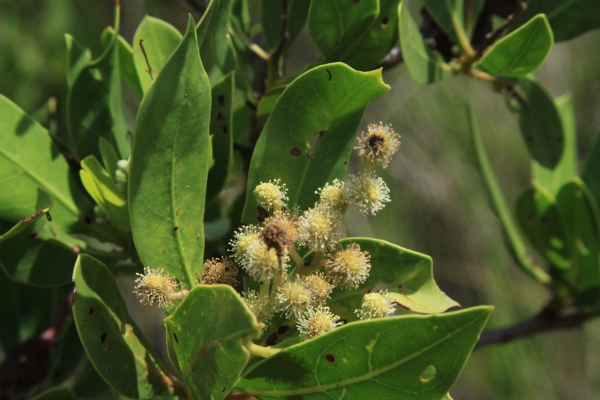Conocarpus erectus
Combretaceae
A few years ago John and I botanizing on Hutchinson Island along the shore noticed a lot of Buttonwoods to have weird stunted growth characterized by vast numbers of stunted branches in tight clusters. This is more or less a “witch’s broom,” a broad term for deformations in various plant species caused by various “things” interfere with growing branchlets. If the growing tips are killed repeatedly, new growth comes forth, only to die, followed by more new growth, etc. etc. until you have a “broom.” Tip killers include smog, mites, microbes, herbicides, and who knows what else. I guess at the time, puzzled, we were superficially inclined to attribute the witch’s brooms to cold salty January ocean winds. The damage seemed worst on exposed trees. Maybe from nasty winds. Probably not.
Then over the last few days there it was again on Jupiter Island in the same type of seashore habitat several miles south of Hutchinson. Again the damage is widespread, conspicuous, and unevenly distributed. This renewed my curiosity.

Witch’s broom on Jupiter Island a few days ago
What do you do when you’re curious? Google! Doing that turned up deformed Conocarpus cultivated in Iran with the trouble attributed to a a pathological microbe. Could be something similar here but the Iran damage looks different from the Florida trouble. Unlike the case in Iran, I’ve encountered damage only on seashore individuals, as if maritime conditions are a factor either directly or as a stress, or merely chance, given that Conocarpus is a seashore species, so except for cultivation, seashore habitats are its home.
More Googling led to the UF/IFAS blog of a year ago 12 Nov 2021 by Michelle Leonard-Mularz showing damage identical to that Hutchinson Island and on Jupiter Island but much farther south, in the Keys, no doubt again near the sea, although less prone to cold January winds than Hutchinson Island and Jupiter Island. That blog attributed the witch’s brooms to the ALS inhibitor herbicides, for example Image, taken up by the roots.

Witch’s broom in the Keys from IFAS blog
That’s probably correct, although perhaps short of proven beyond the shadow of a doubt. The damage being near the sea casts a small shadow of a doubt, and I see the damage among mangroves where I don’t think there ought to be root-uptake herbicides, but you never know. In all cases there are roads nearby, with roadsides weeds conceivably suppressed the chemical way. This IFAS publication shows (Figure 4) stunting on a Conocarpus in a nursery pot, attributed to herbicide
In any case, time will tell more along the seashores where a lot of naturally occurring Buttonwoods are in obvious distress from Martin County to the Keys. When you get around that habitat, take a glance at the Buttonwoods, and be careful with the herbicides. The modern types kick ass.

Healthy individual in flower
Michael Yustin
November 4, 2022 at 8:45 am
There is a Sri Lankan weevil that is doing a number on the buttonwoods.
That does look like herbicide. Do you have a GPS location?
https://entnemdept.ufl.edu/creatures/orn/sri_lankan_weevil.htm
George Rogers
November 4, 2022 at 1:06 pm
Mike, Thanks for that re. the weevil. Will have to watch for that too. Don’t have coords for the witch’s brooms on Jupiter Island but very easy to find good example of the damage. In the green mangrove belt between the road and the Intracoastal directly across the road from the N side of Coral Cover Park. Across from the park there is a grassy strip where beachgoers park. At the very N end of that strip a rail fence separates the “parking strip” from the adjacent property. You can see some w-brooms right there by looking into the mangrove area and walking southward along the parking strip.